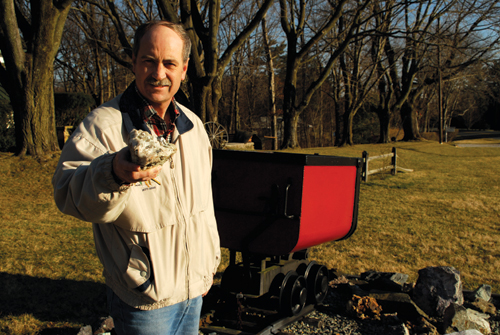
Johnny Johnsson, a resident of Finksburg and a recognized authority on carrollite, holds a hunk of the mineral named after Carroll County.
Did you know that Carroll County has a mineral named after it.
For years after it was first discovered, Carroll County was the only place in the world that Carrollite was known to exist. Then, slowly, other deposits were discovered on other continents and in other countries. Now there are even a few other places in the United States where it has been found.
The place where it was first discovered is lost, but the name remains not only to mark Carroll County’s place in Maryland, but in the world.
Carroll County attracted the attention of prospectors in 1846. They weren’t looking for something new or unknown. They wanted to find useful minerals or metals that would make them money – copper, gold, silver, iron, even coal.
Isaac Tyson, Jr., a Baltimore Quaker, realized that there were significant deposits of iron and copper beneath the southern end of the county. With a large market like Baltimore City and a rail line both close by, the area that came to be called the Sykesville Mining District was an ideal location.
Mine shafts were sunk and copper dug from the ground at the Springfield, Carroll and Mineral Hill mines, which formed the bulk of mining operations in Carroll County.
Edward Remington had a different idea about where to find ore. He purchased the 320-acre “Elms” estate from Samuel Wildesen in 1850 that was located near the Westminster Turnpike. He then secured mineral rights, gathered investors and created the Patapsco Mining Company in May 1850.
As Wildesen’s company dug copper from its mine, something different came out in 1852.
“They thought it was iron ore at first,” said Johnny Johnsson. He lives in Finksburg and is considered by state mineral clubs and the county historical society to be the authority on Carrollite.
What they found was an ore that was made up of large parts of copper and cobalt. No one knew what it was, let alone what to do with it. A scientist was brought in to test and study the ore. He deemed it something new. It was named Carrollite because of the location of the mine (Finkite or Patapscite just don’t have the same ring to them).
“Carrollite is the most renowned mineral in the linnaeite series. Collectors everywhere treasure the magnificent octahedral crystals from Katanga in the Congo. Maryland Carrollite, though nowhere near so visibly spectacular, is difficult to come by on the market and likely to command top dollar wherever and whenever it appears,” Jack Slagle wrote in his article “Carrollite and the Cobalt Sulphides of Carroll County, Maryland” on his website, Mineral Bliss.
The discovery was timely. “With the increased scientific, chemical manufacture and metallurgical interests in metal such as cobalt and nickel in Philadelphia in the 1850s, the company was reorganized in July 1852 for 50 years for the purpose of also exploiting the cobalt content of the ores,” Johnsson wrote in a 1998 article in Matrix: A Journal of the History of Minerals.
William L. Faber first described Carrollite in an 1852 issue of the American Journal of Science, based on samples of the ore he received from the Patapsco Copper Mine.
But the shift in the company’s direction may have hastened its failure. Mine captain Edward Powers wrote, “This was a most unfortunate step for the company, and was, to my notion, the ultimate cause of its finally ceasing to work the mine.”
Although the Patapsco Copper Company failed, other companies continued to work the area, but the effort was never highly profitable.
The following year, questions started being asked about whether Carrollite was actually a new mineral or just a form of cobalt. Tests run on samples of Carrollite, supposedly from the mines, showed that the composition of the samples did not match what Carrollite was supposed to be.
“Significant doubts linger as to whether Carrollite actually exists in the Patapsco Mines where it was initially Ôdiscovered,’” Johnsson wrote.
In the intervening years, Carrollite that matched the chemical composition of the original ore was discovered in other countries, although the mine that had given the mineral its name remained questionable as a valid source of it.
It wasn’t until 1942 that a group of Princeton University graduate students visited the Patapsco Copper and Cobalt Mine and found samples of Carrollite from the mine dumps where unused rock from the mine was discarded.
“The samples they found were tested and proved to be Carrollite,” Johnsson said.
Thus, the Patapsco Copper Mine remained the first source for Carrollite.
When Maryland Route 140 was being constructed, its path brought it near the Patapsco Mine. Too close, apparently: A bulldozer tumbled 20 feet into a shaft that collapsed during the road construction. Workers then covered up part of the mine site with deep fill to create a stable base that could support the highway.
“Any remote chances of field-collecting Carrollite at its type locality were removed by the folks who fenced off, posted, and then buried the last remaining dump from the Patapsco Mines beneath tons of heavy trash,” Slagle wrote.
Noranda Exploration became interested in mining the area for Carrollite in the 1980s and the company sought mining rights.
“Once again, interest returned to the cobalt content recognized with the discovery of carrollite in 1852, returning full-circle in keeping with the sense of irony associated with the Patapsco Copper Mines,” Johnsson wrote in Matrix.
Today, Carrollite is found in mines in Australia, Austria, Azerbaijan, Brazil, Bulgaria, Canada, Chile, China, the Czech Republic, the Democratic Republic of Congo, France, Germany, Japan, Morocco, Namibia, North Korea, Norway, Oman, Poland, Romania, Russia, Slovakia, Sweden, Switzerland and Zambia, but its original home will always be Carroll County.

